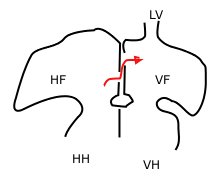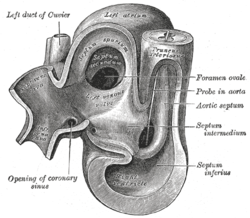
Back ثقبة بيضوية (القلب) Arabic Foramen ovale BS Forat oval del cor Catalan Foramen ovale Czech Foramen ovale (Herz) German Foramen oval (corazón) Spanish Foramen ovale (cœur) French הנקב הסגלגל HE Foro ovale di Botallo Italian 卵円孔 Japanese
| Foramen ovale (heart) | |
|---|---|
 Sketch showing foramen ovale in a fetal heart. Red arrow shows blood from the inferior cava traveling to the right atrium and then to the left atrium. HF: right atrium, VF: left atrium. HH and VH: right and left ventricle. The heart still has a common pulmonary vein (LV), instead of four. | |
 Heart of human embryo of about thirty-five days, opened on left side. | |
| Details | |
| Precursor | Septum secundum |
| System | Cardiovascular system |
| Identifiers | |
| MeSH | D054085 |
| TA98 | A12.1.01.007 |
| TA2 | 3967 |
| FMA | 86043 |
| Anatomical terminology | |
In the fetal heart, the foramen ovale (/fəˈreɪmən oʊˈvæli, -mɛn-, -ˈvɑː-, -ˈveɪ-/[1][2][3]), also foramen Botalli or the ostium secundum of Born, allows blood to enter the left atrium from the right atrium. It is one of two fetal cardiac shunts, the other being the ductus arteriosus (which allows blood that still escapes to the right ventricle to bypass the pulmonary circulation). Another similar adaptation in the fetus is the ductus venosus. In most individuals, the foramen ovale closes at birth. It later forms the fossa ovalis.
- ^ "foramen". Merriam-Webster.com Dictionary. Retrieved 2016-01-22. "ovale". Merriam-Webster.com Dictionary. Retrieved 2016-01-22.
- ^ "foramen". Lexico UK English Dictionary. Oxford University Press. Archived from the original on 2020-09-30.
- ^ "foramen". Dictionary.com Unabridged (Online). n.d. Retrieved 2016-01-22.